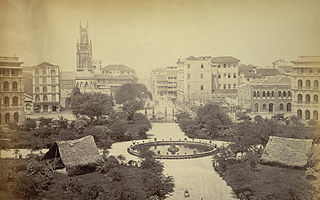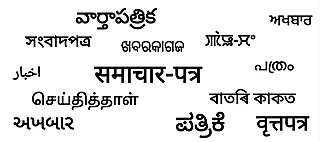Related Research Articles

A tabloid is a newspaper with a compact page size smaller than broadsheet. There is no standard size for this newspaper format.

Filmfare is an Indian English-language fortnightly magazine published by Worldwide Media. Acknowledged as one of India's most popular entertainment magazines, it publishes pieces involving news, interviews, photos, videos, reviews, events, and style. The magazine also annually gives the Filmfare Awards, the Filmfare Awards South, the Filmfare Awards East, the Filmfare Marathi Awards, the Filmfare Awards Punjabi, the Filmfare OTT Awards, the Filmfare Short Film Awards, and the Filmfare Style & Glamour Awards.

The Horniman Circle Gardens is a large park in South Mumbai, India, which encompasses an area of 1.01 hectares. It is situated in the Fort district of Mumbai, and is surrounded by office complexes housing the country's premier banks. Designed to be a large open space with grand buildings in the middle of the walled city, the area had been known as Bombay Green in the 18th century, later Elphinstone Circle. Following India's independence in 1947, the area was renamed in honour of Benjamin Horniman, editor of The Bombay Chronicle newspaper, who supported Indian independence.
Vir Sanghvi is an Indian print and television journalist, author, columnist and talk show host. He has been a member of many professional, academic and government bodies including the National Integration Council. Currently, he is a member of the Broadcast Content Complaint Council (BCCC), a body that regulates content on entertainment TV channels and Co-Founder/Lead Food Critic at EazyDiner. He is an opponent of the Hindutva ideology.

Basu Chatterjee was an Indian film director and screenwriter in Hindi Cinema.

Madhyamam is a Malayalam-language newspaper published in Kerala, India, since 1987. It was founded by Ideal Publications Trust run by the Jamaat-e-Islami Hind wing in Kerala. It has nine editions in India and its Persian Gulf edition Gulf Madhyamam has nine in the Middle East.

Commander K. M. Nanavati vs. State of Maharashtra was a 1959 Indian court case where Kawas Manekshaw Nanavati, a Naval Commander, was tried for the murder of Prem Ahuja, his wife's lover. Commander Nanavati, accused under section 302, was initially declared not guilty by a jury, but the verdict was dismissed by the Bombay High Court and the case was retried as a bench trial. The case is often erroneously believed to be the last jury trial in India, but there were several trials afterwards that used juries, some well into the 1960s. Nanavati was finally pardoned by Vijayalakshmi Pandit, newly appointed Governor of Maharashtra and sister of Prime Minister Jawaharlal Nehru.

Jivatram Bhagwandas Kripalani, popularly known as Acharya Kripalani, was an Indian politician, noted particularly for holding the presidency of the Indian National Congress during the transfer of power in 1947 and the husband of Sucheta Kripalani. Kripalani was an environmentalist, mystic and independence activist who was long a Gandhian socialist, before joining the economically right wing Swatantra Party later in life.

Ashok H. Desai was an Indian lawyer, practising in the Supreme Court of India. He held office as the Attorney General of India from 9 July 1996 to 6 May 1998. Earlier, he was the Solicitor General of India from 18 December 1989 to 2 December 1990. He was awarded the Padma Bhushan award and the Law Luminary Award in 2001. He was given an honorary doctorate in "recognition of his contribution to the field of law and jurisprudence" by the North Orissa University in September 2009.
Rustom Khurshedji Karanjia was an Indian journalist and editor. He typically signed his reports as "R. K. Karanjia". He founded the Blitz, a weekly tabloid with focus on investigative journalism in 1941, and ran it for the next four decades. He also founded The Daily, a daily tabloid which was run by his daughter.

Tarun Vijay is an Indian author, social worker and journalist. He was the editor of the Rashtriya Swayamsevak Sangh (RSS) weekly in Hindi, Panchajanya, from 1986 to February 2008. He also writes for the Daily Pioneer.
Romesh Thapar (1922–1987) was an Indian journalist and political commentator. Affiliated with the Communist Party of India (Marxist), Thapar was the founder-editor of the monthly journal Seminar, published from New Delhi, India.

Cine Blitz is a Hindi and English film magazine published every month from Mumbai about Bollywood, Hindi cinema. Started in December 1974, as of 2006, it was one of the top three film magazines in India.

Sudheendra Kulkarni is an Indian politician and columnist.
Marmik meaning: [Straight from the heart/A silent word that goes directly to the Heart] is an Indian weekly published by the Shiv Sena from Mumbai, until publication of its daily Saamana it was Shiv Sena's organ. It is seen as the frontrunner or launchpad for the Shiv Sena party. It focused on issues of common Marathi man or Maratha Manoos including unemployment, influx of migrant, retrenchment of Marathi workers and its office in Ranade Road became the rallying point for Marathi youth. It was Marmik issue on 5 June 1966 which first announced the launch of membership for the Shiv Sena. Bal Thackeray later stated "that not just a cartoon weekly but also the prime reason for the birth and growth of the Sena.".

Benjamin Guy Horniman was a British journalist and editor of The Bombay Chronicle, particularly notable for his support of Indian independence.

Bombay Velvet is a 2015 Indian period gangster film directed and co-produced by Anurag Kashyap, based on historian Gyan Prakash's book Mumbai Fables. It stars Ranbir Kapoor, Anushka Sharma and Karan Johar in lead roles, with Kay Kay Menon, Manish Choudhary, Vivaan Shah and Siddhartha Basu appearing in supporting roles. The film was released on 15 May 2015.
Burjor Khurshedji Karanjia was an Indian film journalist and editor. He was the editor of Filmfare for 18 years, followed by Screen which he edited for 10 years. He also remained the chairman of the National Film Development Corporation of India (NFDC).
The BombayGazette was among the first English newspapers published from Bombay, India.

The Media in Gujarati language started with publication of Bombay Samachar in 1822. Initially the newspapers published business news and they were owned by Parsi people based in Bombay. Later Gujarati newspapers started published from other parts of Gujarat. Several periodicals devoted to social reforms were published in the second half of the 19th century. After arrival of Mahatma Gandhi, the Indian independence movement peaked and it resulted in proliferation of Gujarati media. Following independence, the media was chiefly focused on political news. After bifurcation of Bombay state, the area of service changed. Later there was an increase in readership due to growth of literacy and the media houses expanded its readership by publishing more editions. Later these media houses ventured into digital media also. The radio and television media expanded after 1990.
References
- ↑ Vir Sanghvi (2 February 2008). "Karanjia and his Blitz". Hindustan Times. Archived from the original on 2 May 2014.
- ↑ The tabloid and the city, in Mumbai Fables, Gyan Prakash, Princeton University Press, 2010, p. 158-204
- 1 2 3 4 Kulkarni, Sudheendra (2 February 2008). "He launched Blitz on Feb 1, died on Feb 1-it's no coincidence". The Indian Express. Retrieved 24 July 2011.
- 1 2 3 4 "R.K. Karanjia: Living through the Blitz". The Hindu . 6 February 2008. Archived from the original on 9 February 2008. Retrieved 1 May 2014.
- ↑ "Russi Karanjia". Tehelka magazine. 16 February 2008. Archived from the original on 2 May 2014. Retrieved 1 May 2014.
- 1 2 3 4 5 6 7 8 9 10 11 12 13 14 15 "528 Gyan Prakash, Blitz's Bombay". india-seminar.com. Retrieved 5 January 2021.
- ↑ Rodrigues, Mario (4 November 2019). "On 30th anniversary, India's greatest cycle race remembered". Sports Lounge. Retrieved 5 January 2021.
- ↑ "Sena leader Gopal Rajwani shot dead". Rediff. 25 January 2000. Archived from the original on 9 September 2012. Retrieved 1 May 2014.
- ↑ Menezes, Saira (29 May 1996). "A Renewed Blitz". Outlook. Retrieved 6 October 2018.